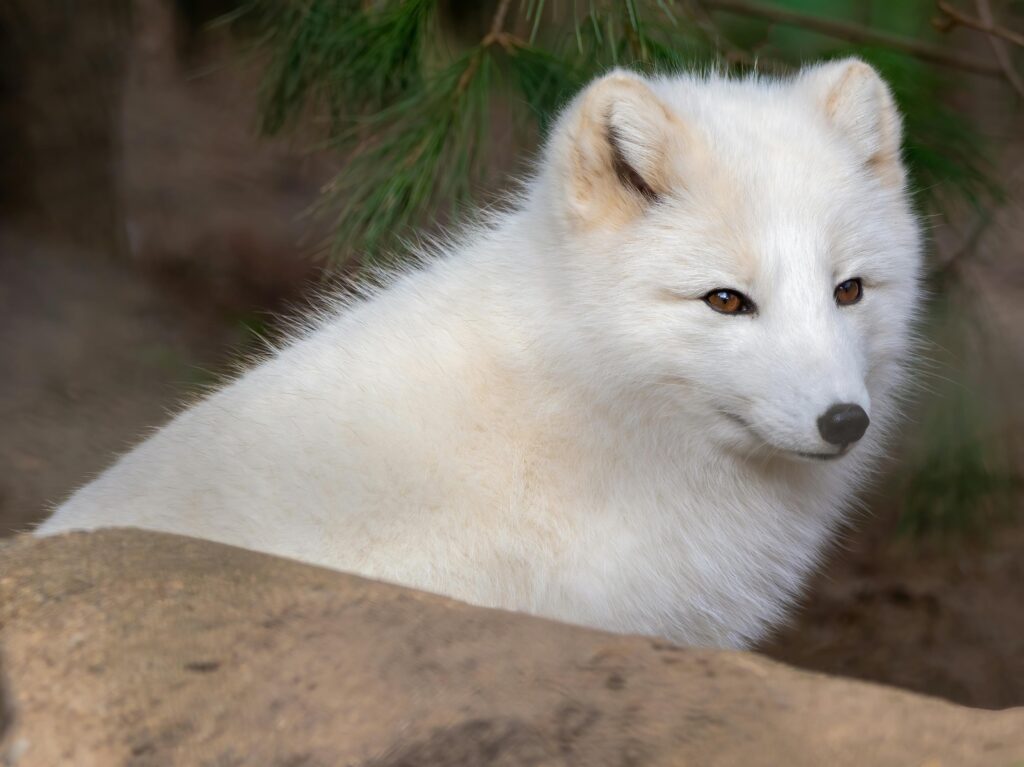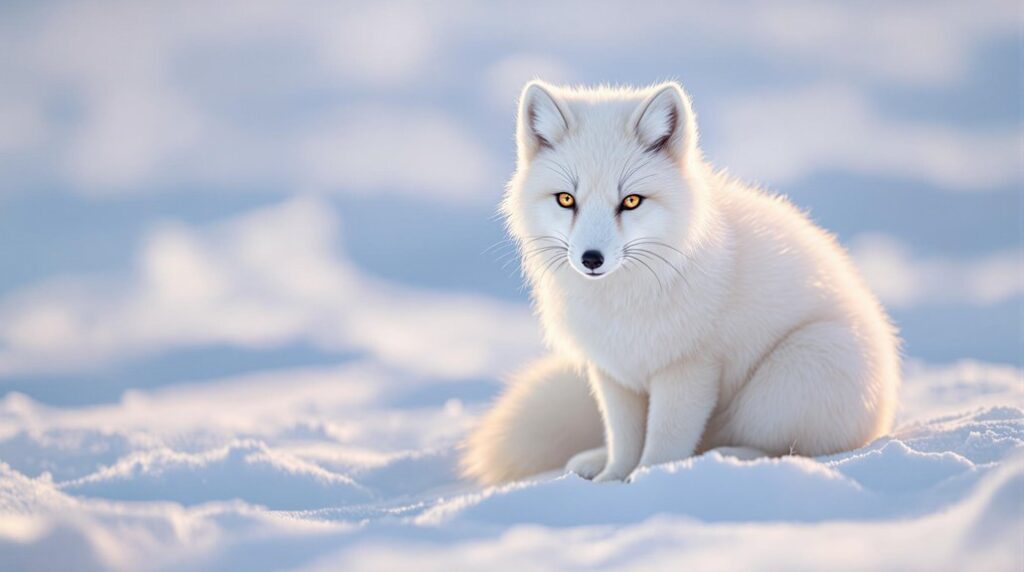Arctic fox facts reveal these incredible survivors inhabit the circumpolar Arctic tundra across northern Europe, Asia, North America, and Greenland. Compact animals weighing 6–10 pounds, they change coat color seasonally from white in winter to darker in summer. Highly adaptable hunters, they reduce metabolism by 25% in winter, cache food for survival, and live in complex family units with cooperative breeding. Their thick fur and specialized hearing make them perfectly suited for harsh Arctic conditions, showcasing a range of fascinating adaptations.
Where Arctic Foxes Live and Thrive
While most animals struggle to survive in Earth’s harshest environments, arctic foxes have mastered life across the circumpolar regions of the Arctic tundra.
You’ll find them throughout northern Europe, northern Asia, North America, Greenland, Iceland, and various Arctic islands including Svalbard and Alaska’s Bering Sea islands.
These adaptable foxes thrive in treeless tundra and alpine environments, even at elevations reaching 3,000 meters above sea level. Arctic foxes also inhabit boreal forests, expanding their range beyond the traditional tundra landscape.
You’ll notice they’ve developed specialized traits for different habitats—coastal blue morphs blend with cliffs while inland white morphs camouflage with snow.
They’ll hunt on pack ice near the North Pole and create complex underground burrows with up to 100 entrances for protection against extreme temperatures.
Physical Features and Seasonal Adaptations
Arctic foxes possess remarkable physical adaptations that allow them to flourish in these extreme environments.
Compact, rounded bodies with short legs and small ears minimize heat loss by reducing exposed surface area. These foxes weigh 6-10 pounds and measure 18-27 inches long, with males slightly larger than females.
Their most striking feature is seasonal color adaptation.
Arctic foxes exhibit two distinct color phases: white morphs that predominate in northern regions, and blue phases commonly found on coastal islands. White foxes transition to brown coats during summer months, while blue foxes maintain their dark coloration year-round.
Their bushy 13-15 inch tails serve multiple purposes—providing balance, insulation, and wrapping around their bodies for warmth.
Dense winter fur traps insulating air, while specialized countercurrent heat exchange keeps their paws functional above freezing temperatures. These foxes possess exceptional hearing that enables them to detect prey moving beneath layers of snow.
Survival Strategies in Extreme Cold

Survival in Arctic conditions demands extraordinary adaptations that push biological limits to their absolute maximum.
Arctic foxes reduce their metabolic rate by 25% during winter, conserving valuable energy when food becomes scarce. Their countercurrent heat exchange system prevents heat loss through their legs, while thick fur and dense undercoats provide insulation against temperatures below -50°C.
These foxes create burrow networks and utilize subnivean spaces under snow for protection from wind and predators. They’ll minimize movement during extreme cold and employ compact den structures that trap warm air. Their long, bushy tail provides crucial protection against blizzards, as foxes curl up underneath it during the most severe weather conditions.
You’ll observe their stealthy stalking techniques and deep-snow hunting methods, where they pin their ears back against the cold while detecting prey beneath the snow. Food caching and scavenging behaviors ensure survival during extended food shortages.
Social Behavior and Family Life
Beyond their remarkable physical adaptations, Arctic foxes demonstrate sophisticated social structures that enhance their survival in one of Earth’s harshest environments.
You’ll find these foxes typically form monogamous pair bonds, often staying together for life. Their family units commonly include one male, two vixens, and offspring, with the second female often being an older sibling from previous litters.
You’ll observe cooperative breeding where fathers actively help raise pups, and older offspring assist with feeding, grooming, and protection duties.
Family members share hunting responsibilities and regurgitate food for newborns. They maintain complex dens with tunnel systems, nesting chambers, and food storage areas that multiple generations use.
Through vocalizations, scent marking, and coordinated hunting strategies, these foxes create stable social hierarchies that dramatically improve pup survival rates. All pups naturally leave their natal territory by six months of age as part of their development cycle.
Population Status and Conservation Challenges
While Arctic foxes have developed remarkable social adaptations for survival, their long-term future faces significant uncertainty across their circumpolar range.
Their populations fluctuate significantly worldwide—ranging from 630,000 individuals during normal cycles to 920,000 during peak years when prey is abundant. However, regional situations vary dramatically. Nordic countries now support only 120 Arctic foxes in total, resulting in their dens receiving full legal protection.
Arctic foxes face several major threats including limited prey availability, climate change effects on sea ice, and competition from red foxes expanding into their Arctic habitats. While globally categorized as “Least Concern,” specific regional populations face significant challenges. Historically, the fur industry heavily impacted Arctic fox numbers because of their valuable pelts, although hunting pressures have diminished in recent years.
Iceland’s conservation success story shows promise—decades of reintroduction efforts increased their population from near extinction to 550 individuals by 2025, demonstrating effective conservation can work.
Arctic Fox Facts: Remarkable Characteristics and Abilities
Arctic foxes possess an extraordinary arsenal of adaptations that make them among nature’s most specialized cold-weather survivors.
These remarkable animals can maintain their core body temperature at 100°F even in subzero conditions through their thick, layered fur and substantial fat reserves that add 50% to their body weight in autumn.
Their compact bodies feature short limbs, small rounded ears, and thickly padded paws that provide ice traction while preventing frostbite.
You’ll notice their dramatic seasonal color changes from brown-grey summer coats to pristine white winter fur, occurring without molting errors for perfect camouflage. A rare blue phase occurs in only 1-5% of Arctic fox populations, displaying darker blue-gray coloration in summer and pale blue-gray in winter.
Their specialized circulatory system regulates paw temperature independently, while their keen hearing and ambush tactics make them exceptional hunters capable of detecting prey beneath snow.
Arctic Fox Facts; Final Thoughts
Arctic fox facts truly showcase how remarkable these small predators are. From their incredible seasonal coat changes, which allow them to blend seamlessly into the snowy winter tundra or the summer’s rocky landscape, to their clever food-caching strategies that help them survive the harshest months, these animals are masters of adaptation. Their social lives are equally fascinating—living in cooperative family units where older foxes help raise the young and teach them essential survival skills.
Add to that their thick, insulating fur, sharp senses, and ability to adjust their metabolism in extreme cold, and it becomes clear that Arctic foxes are perfectly equipped for life in one of the planet’s most unforgiving environments.
Learning about these traits not only deepens our appreciation for their resilience and ingenuity but also reminds us of the urgent need to protect their fragile Arctic habitats. With climate change, habitat loss, and competition from red foxes posing growing threats, it is more important than ever to ensure that these incredible animals can continue to thrive for generations to come.
References
- https://en.wikipedia.org/wiki/Arctic_fox
- https://arcticportal.org/maps/download/maps-arctic-fauna/3517-arctic-fox-distribution-and-movement
- https://animaldiversity.org/accounts/Vulpes_lagopus/
- https://www.canids.org/species/view/PREKKS663901
- https://buffalozoo.org/animal/arctic-fox/
- https://www.adfg.alaska.gov/index.cfm?adfg=arcticfox.printerfriendly
- https://nhpbs.org/natureworks/arcticfox.htm
- https://www.columbuszoo.org/animals/arctic-fox
- https://www.oneearth.org/species-of-the-week-arctic-fox/
- https://arcticwildlifeknowledge.com/arctic-foxes-winter-survival-strategies/

Erzsebet Frey (Eli Frey) is an ecologist and online entrepreneur with a Master of Science in Ecology from the University of Belgrade. Originally from Serbia, she has lived in Sri Lanka since 2017. Eli has worked internationally in countries like Oman, Brazil, Germany, and Sri Lanka. In 2018, she expanded into SEO and blogging, completing courses from UC Davis and Edinburgh. Eli has founded multiple websites focused on biology, ecology, environmental science, sustainable and simple living, and outdoor activities. She enjoys creating nature and simple living videos on YouTube and participates in speleology, diving, and hiking.
🌿 Explore the Wild Side!
Discover eBooks, guides, templates and stylish wildlife-themed T-shirts, notebooks, scrunchies, bandanas, and tote bags. Perfect for nature lovers and wildlife enthusiasts!
Visit My Shop →
